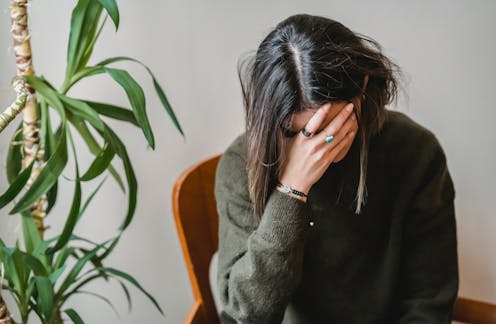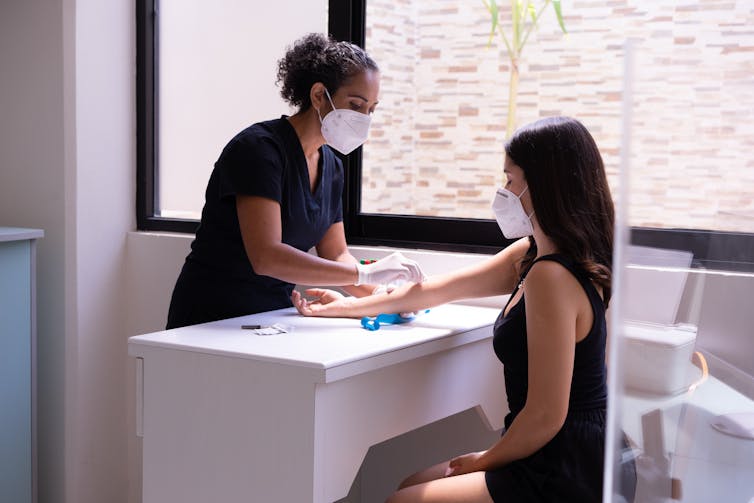
Ever heard "low testosterone" blamed for low mood, brain fog and loss of vitality? Despite all evidence to the contrary, social media influencers are increasingly promoting testosterone therapy as an elixir for women experiencing troubling symptoms of menopause.
Author
Susan Davis
Chair of Women's Health, Monash University
In a series of documentaries and social media posts about menopause in 2021 and 2022, British TV presenter Davina McCall promoted the use of testosterone therapy in addition to standard menopausal hormone therapy. The "Davina effect" has helped fuel a ten-fold increase in prescribing of testosterone for women in the United Kingdom since 2015.
Data isn't available for Australia, but in my clinical practice, women are increasingly asking to have their testosterone level checked, and seeking testosterone to treat fatigue and brain fog.
But while testosterone continues to be an important hormone before and after menopause, this doesn't mean women should be having a blood test to get their testosterone levels checked - or taking testosterone therapy.
What does testosterone do?
Testosterone is an important hormone in women's bodies, affecting the blood vessels, skin, muscle and bone, breast tissue and the brain. In both women and men, testosterone can act on its own or be converted into estrogen.
Before menopause, testosterone is made in the ovaries, where it helps developing eggs grow and aids in estrogen production.
The ovaries release both testosterone and estrogen into the bloodstream, and the levels of the two hormones in the blood peak around ovulation.
Some of the testosterone measured in blood is also produced outside the ovaries, such as in fat, where it is made from "pre-hormones" secreted by the adrenal glands. This source of production of testosterone takes over after menopause.
Do we have more testosterone before menopause?
The claim is often made that pre-menopausal women have more testosterone in their bloodstream than estrogen, to justify the need for testosterone replacement after menopause.
But, when sex hormones have been measured with precision, studies have shown this is not true. Our research found estrogen levels are higher than testosterone levels at all stages of the menstrual cycle.
Blood testosterone levels fall by about 25% between the ages of 18 and 40 years in healthy women. The fall in testosterone coincides with the decline in eggs in the ovaries but whether this is a marker of the decline, a consequence, or a cause of the decline is not known.
From around 40, the rate of decline slows and blood testosterone levels don't change when menopause occurs naturally. Studies have not shown testosterone levels change meaningfully during the menopause transition.
Can blood tests detect 'low testosterone'?
Some influencers claim to have a condition called "testosterone deficiency syndrome" or low levels of testosterone detected in blood tests.
But there is no "normal" blood level below which a woman can be diagnosed as having "testosterone deficiency". So there's no such thing as having a testosterone deficiency or testosterone deficiency syndrome.
This is also in part, because women have very low testosterone concentrations compared with men, and most commercial methods used to measure testosterone cannot separate normal from low levels in women with any certainty.
Pre-menopausal women might also be told they have "low" testosterone if blood is drawn early in the menstrual cycle when it is normal for testosterone to be low. (However, it would only be clinically necessary to do this type of blood test to look for high testosterone, in someone with with excessive hair growth or severe acne, for example, not for low testosterone.)

In post-menopausal women, much of the action of testosterone occurs in the tissues where it is made, after which testosterone is either converted to estrogen or broken down before it leaks back into the circulation. So blood testosterone concentrations are not a true reflection of tissue concentrations.
Further complicating the picture is the enormous variability in the effects of testosterone. At a given blood level of testosterone, some women might have oily skin, acne, increased body hair growth or balding, while others will have no such effects.
So, looking for a "low" blood testosterone in women is not helpful.
Can testosterone improve sexual desire? What about other conditions?
There is sound evidence that testosterone therapy may improve sexual desire in post-menopausal women who have developed low sexual desire that bothers them.
This was confirmed by a systematic review of clinical trials comparing testosterone with a placebo or an alternative. These trials, all of which involved a treatment time of at least 12 weeks, showed testosterone therapy, overall, improved desire, arousal, orgasm and sexual satisfaction in post-menopausal women with low desire that caused them distress.
Treatment is only indicated for women who want an improvement in sexual desire (after excluding other factors such as depression or medication side effects) and its success can only be determined by each woman's personal self-reported response.
But there is not enough evidence to show testosterone is beneficial for any other symptom or medical condition. The overall available data has shown no effect of testosterone on mood or cognition.
As such, testosterone therapy should not be used to treat symptoms such as fatigue, low mood, muscle weakness and poor memory, or to prevent bone loss, dementia or breast cancer.
However research continues to investigate these potential uses, including from my research team, which is investigating whether testosterone therapy can protect against bone density loss and muscle loss after menopause.
You can learn more about participating in one of our studies here.
![]()
Susan Davis is supported by the NHMRC, Grant no 2016627, and receives project funding from the NHMRC, MRFF and the Heart Foundation. She has consulted with Lawley Pharmaceuticals (most recently, in 2020) and the company has provided testosterone and matching placebo for her competitively funded clinical trials.






